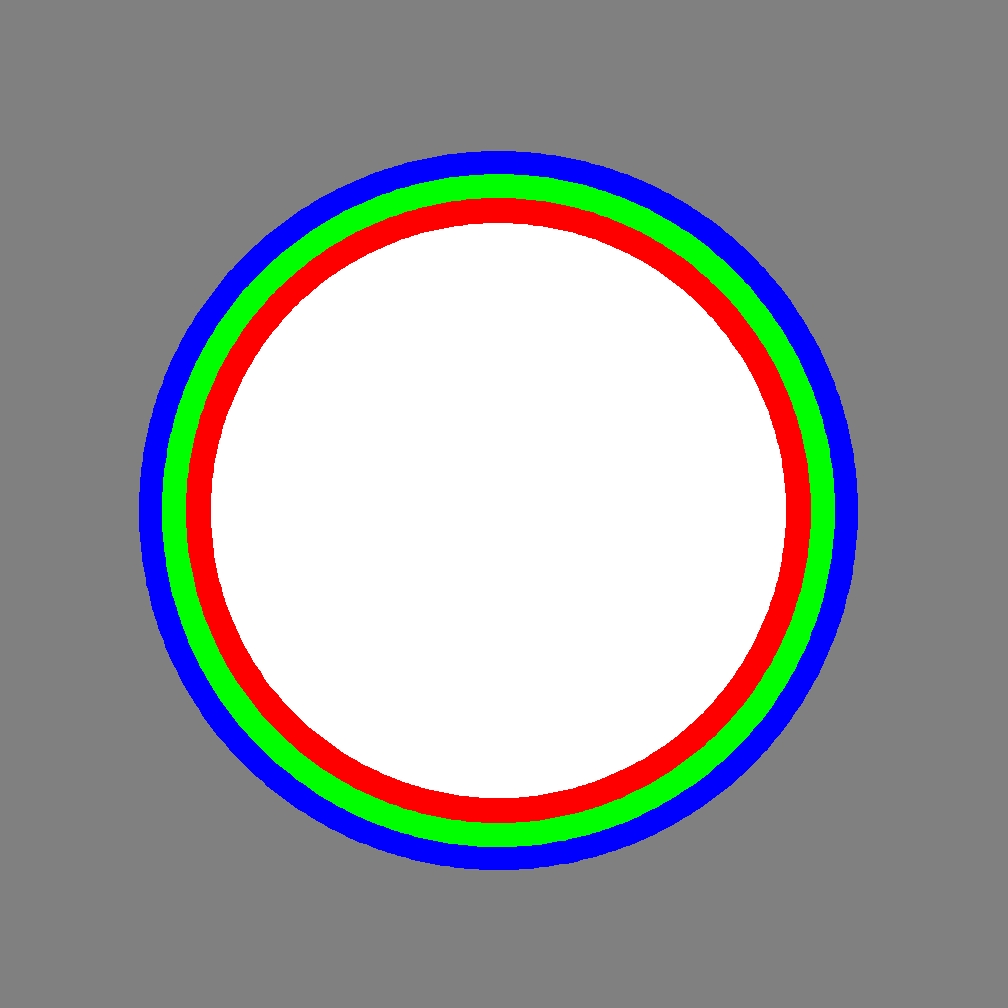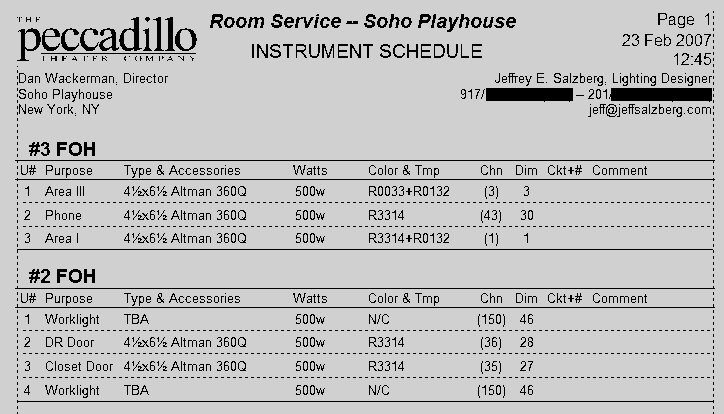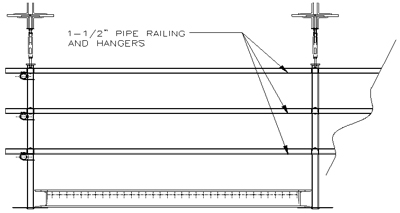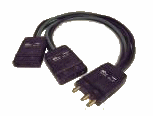|
AEA:
|
"Actors Equity Association". The labor union which, in the United States, represents actors
and stage managers.
|
|
Autofollow:
|
A cue which begins executing as soon as the previous cue is complete. Most computerized consoles can
be programmed to do this automatically.
|
|
Beam Angle:
|
The central portion of the cone of light, in which the intensity does not fall below 50% of maximum.
|
|
Beamlight (or Beam Projector):
|
A lighting fixture with a large parabolic reflector and no lens.
Often used with low voltage lamps (eg 24V, 1000W) Casts
very intense nearly parallel beam. Used frequently in
opera and musicals as a soft edged follow spot.
|
|
Black Wrap TM:
|
A flexible matte black aluminum used to mask light leaks
and shape beams of light. Although often used as a generic
term, "Black Wrap" is a trade mark of GAMPRODUCTS, Inc.
Rosco makes a similar product called "Cinefoil".
|
|
Birdie:
|
A 2" or 2-½" fixture using a dichroic parabolic reflector.
|
|
Blacklight:
|
Ultra-violet light discharge lamp. Most common are actually
 fluorescent tubes, but the phosphor on the envelope emits light
in the near ultraviolet range rather than white light. Other
types include high intensity discharge lamps.
fluorescent tubes, but the phosphor on the envelope emits light
in the near ultraviolet range rather than white light. Other
types include high intensity discharge lamps.

Blacklights cause specially-treated surfaces to fluoresce
while in the absence of visible light, absorptive surfaces
tend to disappear.
|
|
Boom:
|
A vertically-mounted lighting position, usually mounted to
a wall or threaded into a base or flange on the floor. When
booms are mounted downstage of the proscenium, they are
known as box booms.
|
|
C-Clamp:
|
See "pipe clamp"
|
|
Candela:
|
Photometric unit describing the amount of light emitted from a light source.
|
|
Channel:
|
A control path that allows the console to vary the output
level of one or more dimmers or other devices. The channel
can be physical (controlled by a button, switch or slider)
or virtual, (controlled by a numeric keypad).
|
|
Channel Hookup (or
Switchboard Hookup):
|
A spreadsheet listing each fixture in the show with all its relevant
information, including, color, template, accessories, dimmer,
circuit, channel, wattage, and purpose. The channel hookup is
arranged in order of channel number.
|
|
Chromatic Aberration:
|
A type of distortion in which a lens fails to focus all colors to the
same point, resulting in a field of light which looks like this
(exaggerated for effect):

|
|
Color Temperature:
|
A measure of the color of white light. In fact, it is the
color of a "black body" heated up to that particular
temperature in the Kelvin (absolute) temperature scale.
A halogen incandescent lamp usually has a color temperature of
between 3000K and 3600K.
|
|
Count:
|
A Romanian title of nobility. Also, the length of time (in seconds)
it takes to complete a cue.
|
|
Current:
|
The measure of the number of electrons passing a certain
point in one second. Measured in amperes.
|
|
Curtain Warmers:
|
A cue designed to light the grand drape (if used) or uninhabited stage
(if no front curtain is used) in order to give the audience something
at which to look before the performance begins, at intermission,
and after the performance ends.
|
|
Cyclorama (or Cyc):
|
A backcloth colored pale blue, gray, or white, used as a
sky backing. This was originally a curved
architectural plaster background to the stage. Many cloth
cycs are still curved, but flat cycs are more common today.
|
|
Dichroic:
|
A filter or reflector to which a layer of metal oxides is
added, causing it to transmit some wavelengths and reflect
others. Some lighting fixtures use dichroic reflectors,
which reflect light and transmit heat; this enables use of
a much brighter and therefore hotter lamp. Dichroic color
filters transmit only a particular color and reflect all
other wavelengths as well as heat; these are used in
moving lights, as they are the only color filters which
can withstand the intense temperatures within the fixtures.
|
|
Dimmer:
|
A device which regulates light intensity. Most dimmers do
this by electronically controlling the electricity transmitted to the lamp
(See: "SCR"). Fixtures with discharge lamps may have
mechanical dimmers (properly called "dowsers") which regulate the amount of light by
hiding it, similar to Venetian blinds. Older types of dimmers
include autotransformers and resistance dimmers.
|
|
Dimmer Hookup:
|
A spreadsheet listing each fixture in the show with all its relevant
information, including, color, template, accessories, dimmer,
circuit, channel, wattage, and purpose. The dimmer hookup is
arranged in order by dimmer number.
|
|
DMX:
|
Communications protocol used in most theater systems:
consoles, dimmers, and computerized instruments.
Stands for Digital
MultipleX,
meaning signals are encoded
digitally and all signals are sent in sequence through a
single pair of wires.
|
|
Dowser:
|
See: "Dimmer"
|
|
Efficiency:
|
The ratio of emitted light to power consumed.
|
|
Equity:
|
See AEA.
|
|
Field Angle:
|
The outer portion of the cone of light, in which the intensity does not fall below 10% of maximum.
|
|
Foot Candle:
|
Photometric intensity unit: lumen per square foot.
|
|
Gel:
|
Plastic medium used to change the color of a beam of light.
Originally made of animal gelatin. Major manufacturers
include Apollo, GAM, Lee, and Rosco.
|
|
Gobo (or Template):
|
Metal or glass insert used in ellipsoidal reflector spotlights to project patterns.
|
|
Halogen Lamp (or Tungsten Halogen):
|
A lamp whose envelope is filled with halogen rather than
inert gas. In a non-halogen lamp, as the filament
heats up, pieces of it evaporate and are deposited on the inside of
the bulb, changing the color temperature of the lamp. In
a halogen lamp, these pieces combine with the gas and are
redeposited on the filament. This could make for far
greater lamp life but instead has been used to
enable manufacture of brighter, hotter and smaller bulbs.
Due to the heat ordinary glass may not be used for the
envelope; instead, a quartz alloy is used. This collects
grease and therefore should not be touched; grease from
the finger remains on the bulb and causes it to weaken
when hot. It is easy to tell who touched the bulb and
caused a greatly-reduced lamp life; the perpetrator's
fingerprint will be clearly etched on the glass. If the
envelope is inadvertently touched, it can be wiped clean
with alcohol.
Non-halogen lamps are often referred to as "incandescent",
but this is less than accurate, as halogen lamps also use
the principle of incandescence (see "Lamp").
|
|
Hue:
|
That property of light by which the color of an object is
classified as red, blue, green, or yellow in reference to
the spectrum.
|
|
Inkie:
|
A 3" Fresnel-lensed spotlight.
|
|
Instrument Schedule:
|
A spreadsheet listing each fixture in the show with all its relevant
information, including, color, template, accessories, dimmer,
circuit, channel, wattage, and purpose. The instrument schedule is
arranged in order of hanging position and fixture number.

|
|
Iris:
|
A mechanical device used to vary the diameter of the light
from an ellipsoidal reflector spotlight. In most cases,
the iris can easily be inserted into or removed from the fixture.

|
|
Lamp:
|
That which is referred to commonly as a "light bulb". The lamp consists of three parts:
- Filament: The internal
coil of wire which heats up as electricity is passed
through it and thereby glows and produces light. This
process is called incandescence.
- Base: The metal part
of the lamp that connects it to the fixture. There are
many types of base, including prefocus, bayonet, screw,
and two-pin.
- Bulb: The glass envelope
that surrounds and contains the filament.
|
|
LED:
|
Light Emitting
Diode.
Increasingly used as theatrical light sources as growing levels of
light efficiency are reached and control technology is improved.
LEDs are manufactured in
various colors, most commonly red and green.
White LEDS are actually blue with a phosphor envelope
which transforms blue light to white.
|
|
Light Plot:
|
A drawing or drawings showing the location of each fixture,
its fixture type, color, channel, dimmer, and focus.
|
|
Lightwright TM:
|
A computer program used to generate instrument schedules,
channel hookups, and other paperwork from a single
database/spreadsheet with error-checking and many
lighting-specific data entry shortcuts. In the American
professional theatre, Lightwright is the industry
standard lighting database program.
|
|
Lumen:
|
A measure of intensity, related to footcandles.
|
|
Multiplexing:
|
Tthe combining of several different message signals or data streams
into one signal over a shared medium.
|
|
Photometrics:
|
The data used to calculate the field size and intensity of a lighting fixture.
|
|
Pipe Clamp (or C-Clamp):
|
 The clamp that attaches a lighting fixture to the hanging
position. In the US, these are usually made of malleable iron;
in other parts of the world (notably the UK) they are made
of more substantial material.
The clamp that attaches a lighting fixture to the hanging
position. In the US, these are usually made of malleable iron;
in other parts of the world (notably the UK) they are made
of more substantial material.

|
|
Power (or Wattage):
|
The amount of electrical "work" being performed. Measured
in watts.
|
|
Practical:
|
A prop electrical device (usually a lighting fixture such
as a chandelier or table lamp) that actually functions.
|
|
Production Meeting:
|
A meeting of the director, stage manager, designers, and technical department heads, convened to discuss and
facilitate logistical issues. The meeting may also be attended by various representatives of the administrative
staff. In most cases, the production meeting is not an appropriate time for one-on-one discussions between the designer
and director concerning design elements; these will be of little interest to most of the other attendees and will be
an inefficient use of their time.
|
|
Reflector:
|
- A mirror (usually curved) at the rear of a lighting
fixture.
- Anything used to reflect light.
|
|
Resistance:
|
The degree to which a substance opposes the passage of
electricity. Measured in ohms.
|
|
Saturation:
|
The degree of purity of a color; the degree of freedom from
admixture with other colors. Also known as chroma.
|
|
Scroller:
|
 Color changing device placed on a lighting fixture, made of two
cylinders with a long strip of color filters rolled around
them. Digital signals control the movement of the cylinders
to determine which piece of the strip is placed before
the light.
Color changing device placed on a lighting fixture, made of two
cylinders with a long strip of color filters rolled around
them. Digital signals control the movement of the cylinders
to determine which piece of the strip is placed before
the light.
|
|
Shade:
|
A color with a low value. It is usually created by a
mixture of one or more hues with black.
|
|
Shin Busters:
|
Lighting instruments placed at the sides of the stage at or
near floor level, frequently used in dance.
|
|
Silicon Controlled Rectifier (or SCR):
|
An electronic device, similar in function to a transistor,
but can withstand higher voltages. It behaves as a
super-swift valve, opening and shutting to control the
amount of electricity delivered to the lamp.
|
|
Spectrum:
|
In lighting, the band of colors produced when sunlight is
passed through a prism, comprised of red, orange, yellow,
green, blue, indigo, and violet.
|
|
Stage Circuit (or Circuit):
|
The wiring which connects the fixture (usually via an outlet)
to the patch panel or dimmer.
|
|
Tension Grid:
|
(Also known as "Tension Wire Grid" or "TWG")
Provides walking surface over performance area allowing
lighting from any position overhead. Made of interwoven 1/8"
aircraft cable.
|
|
|



[Tension grid images courtesy of Peter Albrecht
Company.]
|
|
Throw:
|
The distance from the fixture to the performer or scenic unit being lighted.
|
|
|
In the example below, the fixture has a
beam angle of 16° and a field
angle of 40°. The throw is
12'. The beam width is 3'-4.5" and the field width is 8'-9".

|
|
Tie Line:
|
(Also known as "trick" line). Cotton rope, usually black, approximately
1/8" in diameter. Uses include tying up cables and draperies.
|
|
Tint:
|
A color with a high value is referred to as a tint.
This is usually achieved by mixing a hue with either
white pigment or white light.
|
|
Tone:
|
A color of middle value, neither a shade nor a tint.
|
|
Transmission:
|
The degree to which a medium passes light, measured in
terms of the percentage of light which is transmitted.
|
|
Twofer:
|
An adaptor allowing two fixtures to be plugged into one circuit.

|
|
Value:
|
The relative lightness or darkness of a color.
Pale blue has a high value, and dark blue has a low value.
|
|
Volt:
|
The unit of electrical pressure or electromotive force.
|
|
Watt:
|
The unit of electrical power.
|
|
Zoom:
|
A zoom lens has the ability to vary its focal length
(and thus the field and beam angles). When a zoom lens is
set to its narrowest setting, the field is brighter than
that of the widest setting.
|